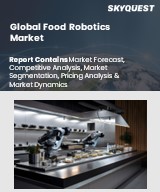
Report ID: SQMIG30C2155
Skyquest Technology's expert advisors have carried out comprehensive global market analysis on the food robotics market, covering regional industry trends and market insights. Our team of analysts have conducted in-depth primary and secondary research to provide regional industry analysis and forecast of food robotics market across North America, South America, Europe, Asia, the Middle East, and Africa.
North America dominated the global food robotics market in 2022, with a major share of more than 32%. The regional food industry is characterized by innovation and a high demand for automation. Factors such as labor costs, food safety regulations and the need for constant process improvement are driving the adoption of food robots. In the U.S. food manufacturers, restaurants and fast-food companies are increasingly integrating robots into their operations. The presence of large food robotics companies and research institutes also contributes to the growth of the market in North America.
The Asia Pacific region in the market is growing rapidly due to its expanding economies, expanding industrial base of food products driven by rapid urbanization, and rising, lucrative demand for convenience foods due to increasing utilization and capacity of consumers. The sector is expected to witness a significant increase in the demand for advanced food processing equipment which helps to reduce the time for cooking and provides productivity improves. The expected increase in food processing facilities in the region is expected to increase the supply and consumption of food and beverage robots. This is expected to have a positive impact on the global food robotics market.
REQUEST FOR SAMPLE
Want to customize this report? This report can be personalized according to your needs. Our analysts and industry experts will work directly with you to understand your requirements and provide you with customized data in a short amount of time. We offer $1000 worth of FREE customization at the time of purchase.
Feedback From Our Clients

Report ID: SQMIG30C2155
sales@skyquestt.com
USA +1 351-333-4748